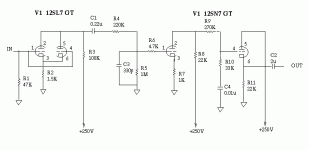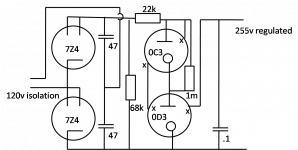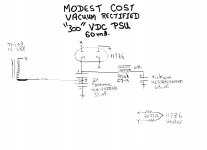I agree with the 6SL7 suggestion. Many 6SL7 specimens have issues with microphonics, but that is easily circumvented by using the Loctal 7F7, which is electrically equivalent to the 6SL7. Remember, Loctal types were intended for mobile service and must be vibration resistant.
BTW, the "12" V. versions of these tubes (12SL7/14F7) may allow some cost savings.
If you're feeling adventurous, a pentode (IMO) worthy of consideration for 1st gain block duty is the 6AC7. Even with partition noise, it might be quiet enough and the high gm allows "gobs" of gain to be extracted.
BTW, the "12" V. versions of these tubes (12SL7/14F7) may allow some cost savings.
If you're feeling adventurous, a pentode (IMO) worthy of consideration for 1st gain block duty is the 6AC7. Even with partition noise, it might be quiet enough and the high gm allows "gobs" of gain to be extracted.
Don't be too careless in substituting an ECC83/12AX7A by a 6SL7 (and vice versa, of course)! The latter one has lower µ (70 vs. 100) and lower plate impedance, which might have an impact on a passive RIAA eq network. E.g. see Kodabmx's schematics above, which was first published by Bob Danielak. I've built that, too, but using ECC83 and ECC82. Hence I had to adjust (decrease) R4 to cope with the ECC83's higher plate impedance.Use the 12AX7/ECC83 design and substitute a near identical IO valve; 6SL7.
Best regards!
You set me off on a quick study of equivalent tubes and I found this:
Similar and equivalent tubes
It suggests the 7B4 and 6SF5 as alternatives to the 12AX7A, and they are even closer than the 6SL7, although they are single rather than double triodes.
I noted some of the critical indicators from the data sheets below, and does anyone know of better equivalents for the 12AU7 and 12AT7?
Tube 12AX7A 7B4/6SF5 6SL7GT
Amplification Factor 100 100 70
Plate Resistance 62,500 66,000 44,000
Transconductance 1600 1500 1600
Example
Plate Voltage 250 250 250
Grid Voltage -2 -2 -2
Plate Current 1.2 .9 2.3
Tube 12A7TA 7F8/6SF5 6SL7GT
Amplification Factor 60 48 70
Plate Resistance 10,900 14,500 44,000
Transconductance 5500 3300 1600
Example
Plate Voltage 250 250 250
Grid Voltage -12 -11 -2
Plate Current 10 6 2.3
Tube 12AU7A 14N7/6SN7
Amplification Factor 17 20
Plate Resistance 77,000 77,000
Transconductance 2200 2600
Example
Plate Voltage 250 250
Grid Voltage -8.5 -8
Plate Current 10.5 9
Similar and equivalent tubes
It suggests the 7B4 and 6SF5 as alternatives to the 12AX7A, and they are even closer than the 6SL7, although they are single rather than double triodes.
I noted some of the critical indicators from the data sheets below, and does anyone know of better equivalents for the 12AU7 and 12AT7?
Tube 12AX7A 7B4/6SF5 6SL7GT
Amplification Factor 100 100 70
Plate Resistance 62,500 66,000 44,000
Transconductance 1600 1500 1600
Example
Plate Voltage 250 250 250
Grid Voltage -2 -2 -2
Plate Current 1.2 .9 2.3
Tube 12A7TA 7F8/6SF5 6SL7GT
Amplification Factor 60 48 70
Plate Resistance 10,900 14,500 44,000
Transconductance 5500 3300 1600
Example
Plate Voltage 250 250 250
Grid Voltage -12 -11 -2
Plate Current 10 6 2.3
Tube 12AU7A 14N7/6SN7
Amplification Factor 17 20
Plate Resistance 77,000 77,000
Transconductance 2200 2600
Example
Plate Voltage 250 250
Grid Voltage -8.5 -8
Plate Current 10.5 9
The Noval (9 pin mini) equivalent of the 6SN7 is the 6FQ7/6CG7. The 12AU7 is non-linear. Restrict the 'U7 to "unity" gain roles (like cathode follower), in HIFI designs.
The 12AT7 is a high transconductance (gm) RF type that has found use in audio applications. Mere amplification factor (μ) rarely tells the whole story.
The 12AT7 is a high transconductance (gm) RF type that has found use in audio applications. Mere amplification factor (μ) rarely tells the whole story.
It's interesting this thread should come up, as I've been considering a scratch-built RIAA stage build over the past week. The three I'm considering:
I've already gathered the parts for Eli's stage, which I like for its novel approach, but I was wondering about the pros and cons of the other two. The JE Labs is attractive because I have boatloads of NOS Loktals, but Vinylsavor's looks to be simpler.
Just want to see what others think here...
I've already gathered the parts for Eli's stage, which I like for its novel approach, but I was wondering about the pros and cons of the other two. The JE Labs is attractive because I have boatloads of NOS Loktals, but Vinylsavor's looks to be simpler.
Just want to see what others think here...
That was going to be my next question (you read my mind). And since the 7F7 is basically a Loktal 6SL7, this might further expand the options for the OP. I've considered the 7F7/6SL7 as a substitute, but was concerned with the different interelectrode capacitance and Mu (the 7F7's 70 vs. 100 for the 12AX7).
I'm fairly handy with flush cutters and a soldering iron, but like the OP my eyesight ain't what it used to be.
I'm fairly handy with flush cutters and a soldering iron, but like the OP my eyesight ain't what it used to be.
I've considered the 7F7/6SL7 as a substitute, but was concerned with the different interelectrode capacitance and Mu (the 7F7's 70 vs. 100 for the 12AX7).
Remember, net gain is controlled by both μ and RP. There's not much difference between the 'X7 and the 'SL7, when you crunch the numbers.
JE rejected the 7B4 because it is a single triode and did not fit his chassis, but it seems to be a direct replacement for the 12AX7 in ratings. Even the capacitances are similar when you recognize that the 7B4 seems to always be measured with a shield, and the 12AX7 without. I don't mind having a forest of tubes, it was -22 F here in northern IL yesterday and my furnace could use the help! So unless someone points out a problem I have missed I will build one of the 12AX7 circuits with the 7B4. The question is which one...
So unless someone points out a problem I have missed I will build one of the 12AX7 circuits with the 7B4.
I would not regard 4 bottles as a "forest". What you have to watch out for in passive EQ setups is matching. Well matched triodes are needed in the channel to channel corresponding positions. Matching of the triodes in a channel is not necessary.
My listing room is not balanced so I guess the tone-stack could take care of miss-matched triodes at the same time?
I have been looking for an excuse to use glow-discharge tubes for the first time, so how about the following for the power supply?
Sticking with the Loktal the 7Z4 makes an inexpensive voltage multiplier. The caps should give me about 300v to fire the regulators (with the 1meg shunt to help).
The 68k resistor is just to drain the caps when powered off for safety.
The 22k resistor limits current through the glow-tubes
x notes the path to remove voltage from the circuit with removal of a regulator.
.1uf should be small enough to prevent oscillation while providing some filtering.
Suggestions?
I have been looking for an excuse to use glow-discharge tubes for the first time, so how about the following for the power supply?
Sticking with the Loktal the 7Z4 makes an inexpensive voltage multiplier. The caps should give me about 300v to fire the regulators (with the 1meg shunt to help).
The 68k resistor is just to drain the caps when powered off for safety.
The 22k resistor limits current through the glow-tubes
x notes the path to remove voltage from the circuit with removal of a regulator.
.1uf should be small enough to prevent oscillation while providing some filtering.
Suggestions?
Attachments
I say, did somebody mention voltage doubler?  The attached "hen scratch" schematic is inexpensive to execute and would work well with gas discharge regulation.
The attached "hen scratch" schematic is inexpensive to execute and would work well with gas discharge regulation.
BTW, the 0.1 μF. noise suppression part is (IMO) pressing your luck, with regards to observing unwanted relaxation oscillator behavior. I think 0.068 μF. is a better choice.
BTW, the 0.1 μF. noise suppression part is (IMO) pressing your luck, with regards to observing unwanted relaxation oscillator behavior. I think 0.068 μF. is a better choice.
Attachments
- Status
- This old topic is closed. If you want to reopen this topic, contact a moderator using the "Report Post" button.
- Home
- Amplifiers
- Tubes / Valves
- Need RIAA phono preamp based on octal or ST


